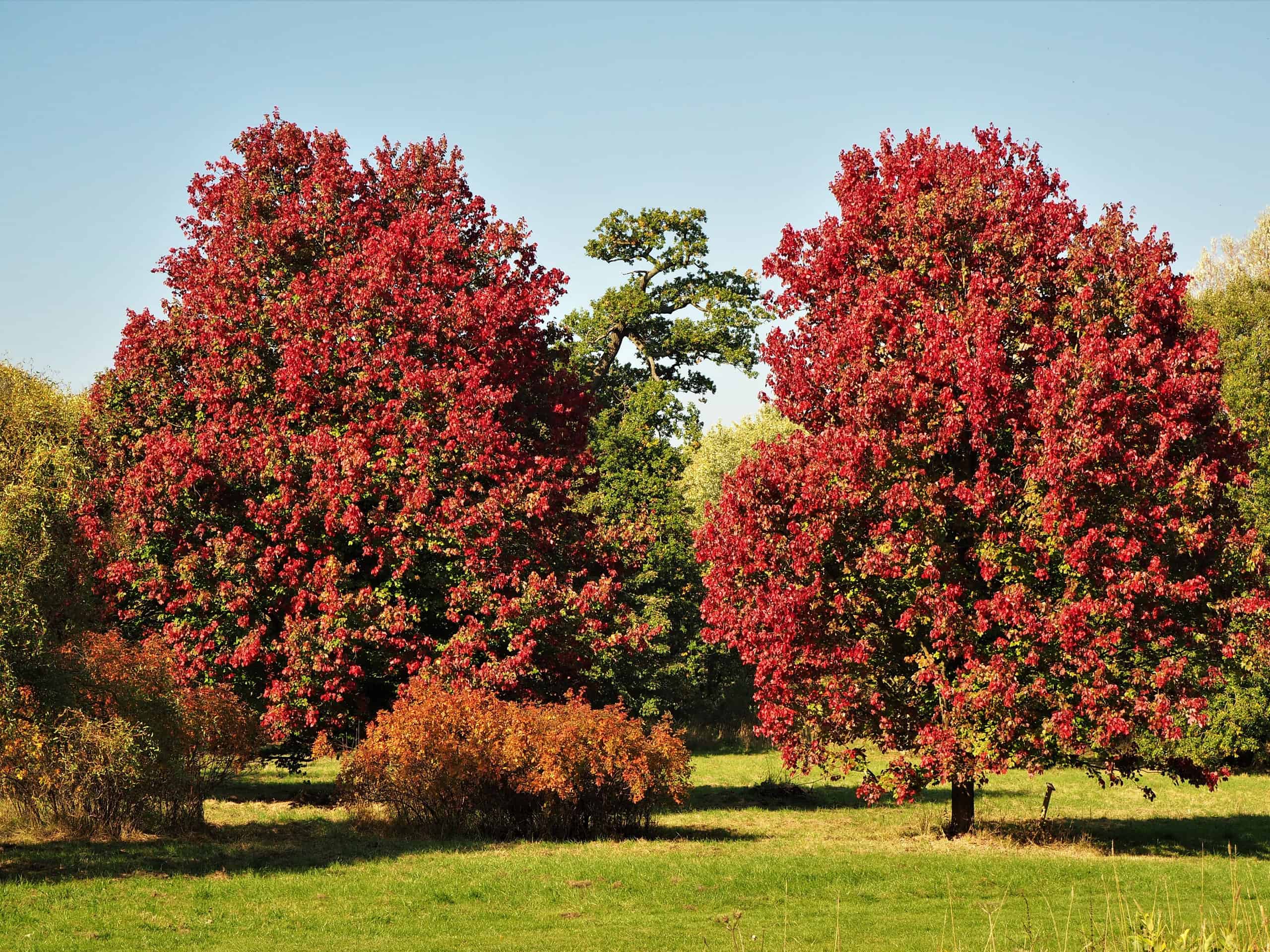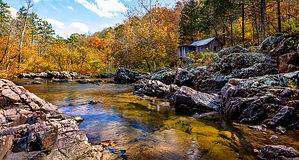Looking to add some shade-loving trees to your garden? Look no further! In this article, we have curated a list of 22 incredible trees that grow in the shade. These trees flourish and thrive in shady environments. From the majestic Japanese maple to the resilient dogwood, discover a variety of amazing trees that will transform your shaded spaces into lush and vibrant retreats.
Very few species of trees can manage in shady environments. But, some will adjust to these conditions quite well. The darker the shade, the more challenging it is for any tree to grow correctly. Here are a few of the most adaptable trees that grow in the shade.
Concolor Fir
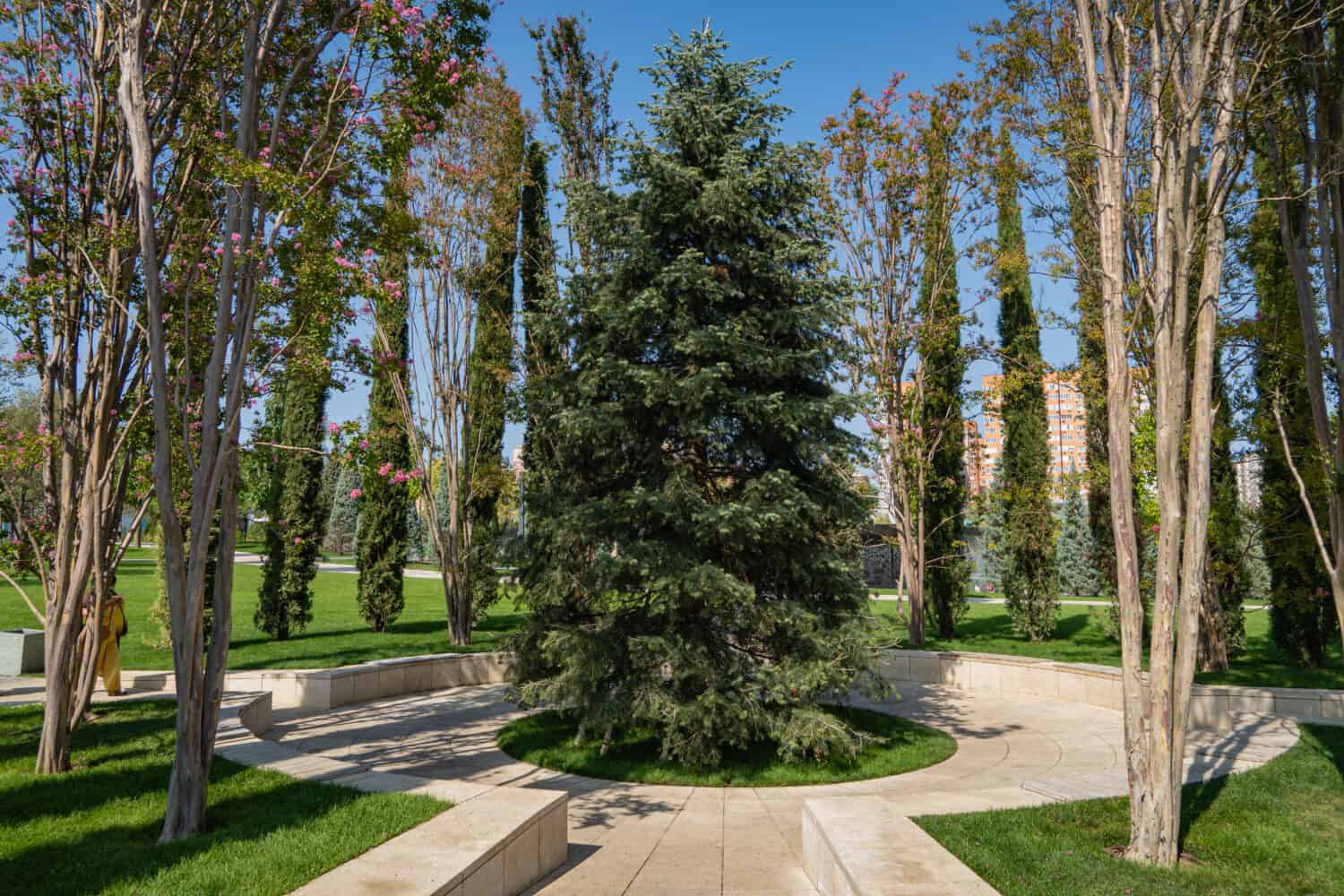
The white fir Abies concolor is a tree that grows well in the shade.
©Alexander Denisenko/Shutterstock.com
This graceful, tall evergreen tree is an attractive addition to any landscape. Concolor fir (Abies concolor) has a pyramidal shape and can reach up to 80 feet tall with a spread of 15-25 feet. Its needles are long and soft with a silvery-blue hue. The cones are a light brown color, and they hang down from the branches in pairs.
The beautiful concolor fir is hardy in zones 4-7. It does best when grown in moist, well-drained soils in an area with light shade. Its dense foliage provides excellent privacy and wind protection, making it an ideal choice for windbreaks and screens.
Red Buckeye
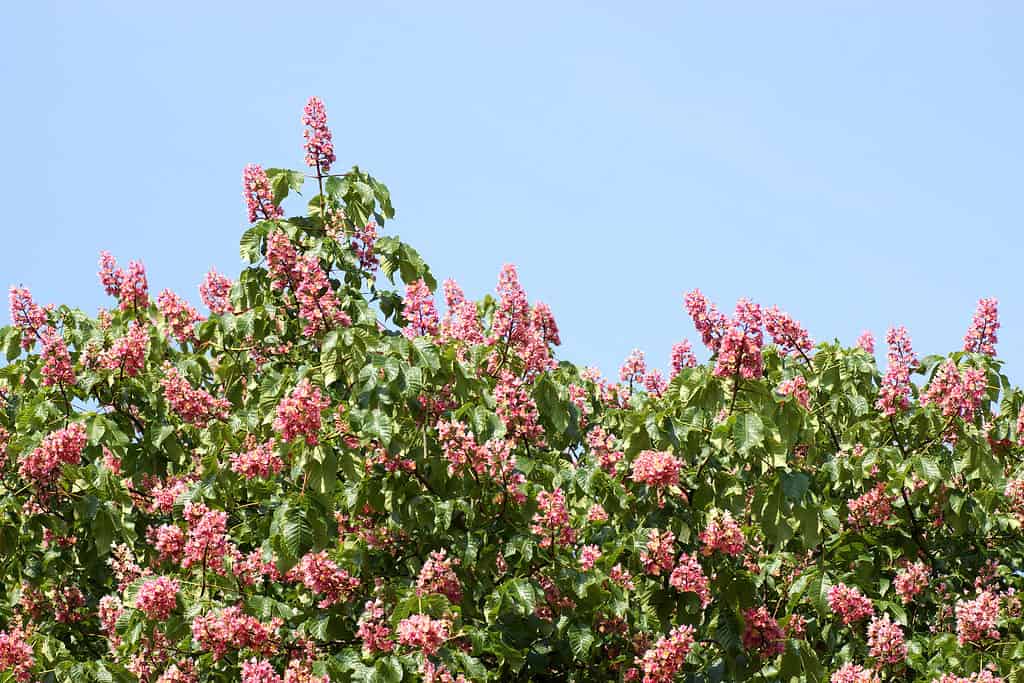
The red buckeye tree grows in the shade and produces beautiful red flowers.
©Bildagentur Zoonar GmbH/Shutterstock.com
Red Buckeye (Aesculus pavia) is a deciduous shrub that typically grows 6-12 feet tall and 6-10 feet wide. It has attractive, glossy leaves that are divided into five leaflets, each of which can be up to 4 inches in length. As it matures, the shrub produces large clusters of bright red flowers, which bloom in early to mid-spring. Red buckeye grows well in light to medium shade and is hardy in zones 5-9.
Black Alder
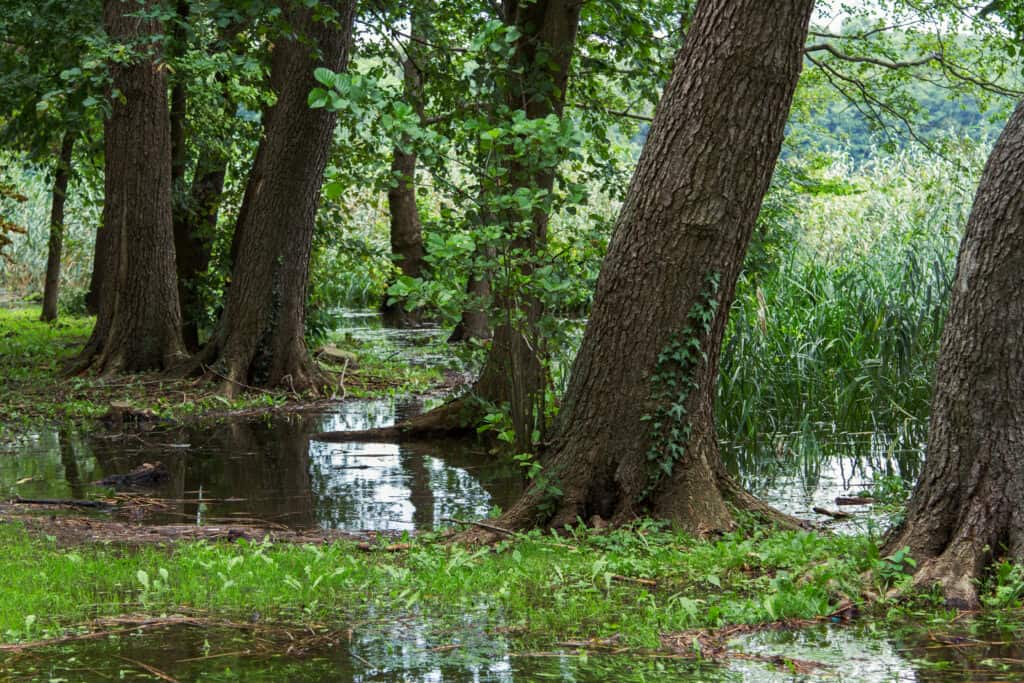
Alder (Alnus glutinosa) is adaptable to both shade and soggy soil.
©Ihor Hvozdetskyi/Shutterstock.com
Black alder (Alnus Glutinosa) is a large deciduous shrub or small tree with a rounded crown. It has a dark, furrowed bark, and its leaves are oval-shaped, dark green, and glossy. Its catkins are long and pendulous, and its fruit is a small nut. This lovely tree is tolerant of a wide range of soils and is particularly happy in moist, heavy soils.
Black alder can reach heights of 40-60 feet and is hardy in zones 4-7. It is a fast-growing species and prefers light to moderate shade. With its attractive shape and foliage, it is an ornamental plant and makes an excellent addition to any landscape. It is also a good choice for wet areas, such as near ponds or streams.
Allegheny Serviceberry

If you have a heavily shaded area, consider a flowering serviceberry tree.
©Wirestock Creators/Shutterstock.com
Allegheny serviceberry, A. laevis, is a multi-stemmed deciduous shrub that can reach heights of 20-30 ft with a width of 15-20 feet. It has a rounded crown with glossy, dark green leaves that are oval in shape and turn yellow, orange, and purple in the fall. Its white spring flowers give way to sweet, edible, dark blue-purple berries in the summer.
It is cold hardy in zones 4-8. This tree grows in the shade, even in the heaviest of shady spaces. Grow it in moist, well-drained soil and use it in areas where erosion control is needed. Additionally, it is a popular choice for wildlife habitats. Its berries are an important source of food for birds and other animals.
Pawpaw
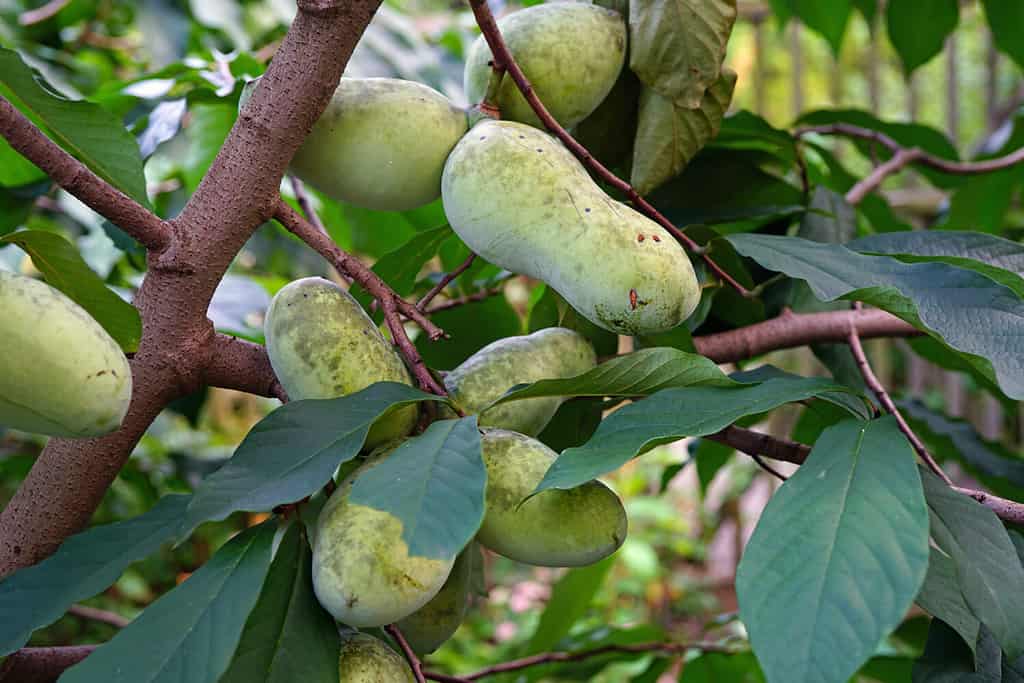
The common pawpaw is a tree that adapts wonderfully to shade.
©EQRoy/Shutterstock.com
Pawpaw (Asimina triloba) is a deciduous tree that is native to the United States and Canada. It is one of the best trees that grows in the shade. It can reach heights of up to 25 feet and has large, light green leaves. Its bark is gray and scaly, and its fruits are oval-shaped and yellowish-brown when ripe. The fruits have a sweet, custardy flavor, and people call them “the banana of the north.”
Pawpaw is a hardy tree that can tolerate a wide range of soil conditions. It grows well in light or heavy shade and is hardy in zones 5-8. It is a low-maintenance tree that does not require pruning or fertilizing and is relatively resistant to pests and diseases.
The flowers of the Pawpaw tree are yellow-green and small and bloom in the spring. The flowers have a sweet, fruity fragrance and attract pollinators such as bees and butterflies. The fruits are edible, and you can use them to make jams, jellies, and other desserts.
American and European Hornbeam

Blue beech trees, or American Hornbeams, adapt very well to deep shade.
©Gerry Bishop/Shutterstock.com
Hornbeams are a type of deciduous flowering tree found in temperate climates. The two most common species of hornbeam are the European hornbeam (Carpinus betulus) and the American hornbeam (Carpinus carolina).
European hornbeams have beautiful fluted grey bark and dense foliage. They can grow up to 40 feet tall and have ovate-shaped leaves, which are dark green and glossy on top with a pale underside. They produce small clusters of yellow-green flowers in the spring, and their fruits are small, three-lobed nuts.
American hornbeams have a similar appearance to the European variety, but they tend to be smaller, only reaching heights of 20-40 feet. The bark is slightly smoother than that of the European hornbeam, and the foliage is slightly larger and more rounded. They also produce the same small clusters of yellow-green flowers and small, three-lobed nut fruits.
Both types of hornbeams thrive in moderate shade and can tolerate some sun. American hornbeam will thrive in even very deep shade. They are very hardy trees and can survive in a wide range of temperatures and soils. European hornbeam is hardy in zones 5-7. American hornbeam is hardy in zones 3-9.
Eastern Redbud
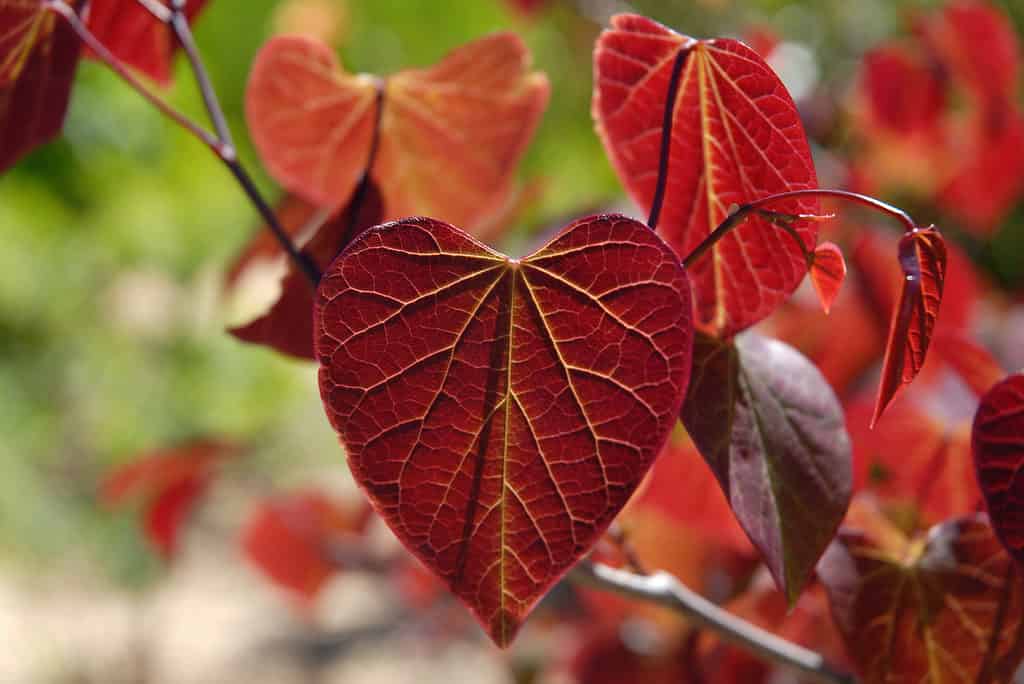
Redbud trees have four seasons of interest, from beautiful spring flowers to bright red fall foliage.
©Josie Elias/Shutterstock.com
Eastern Redbud (Cercis Canadensis) is a deciduous tree that people love for its beautiful heart-shaped leaves and vibrant pink-purple flowers. In early spring, the tree is covered in clusters of small, bright blooms, creating a stunning display. Its leaves are dark green, soft, and glossy and turn a yellow-orange or red color in the fall. The tree has a rounded, spreading canopy and grey-brown bark.
Eastern Redbud is a versatile tree that can thrive in both sun and light shade, making it an ideal choice for many landscapes. It is cold hardy in zones 4-9 and can handle temperatures as low as -30 degrees Fahrenheit. This flowering tree is a beautiful addition to any garden and will bring years of enjoyment.
Pagoda Dogwood
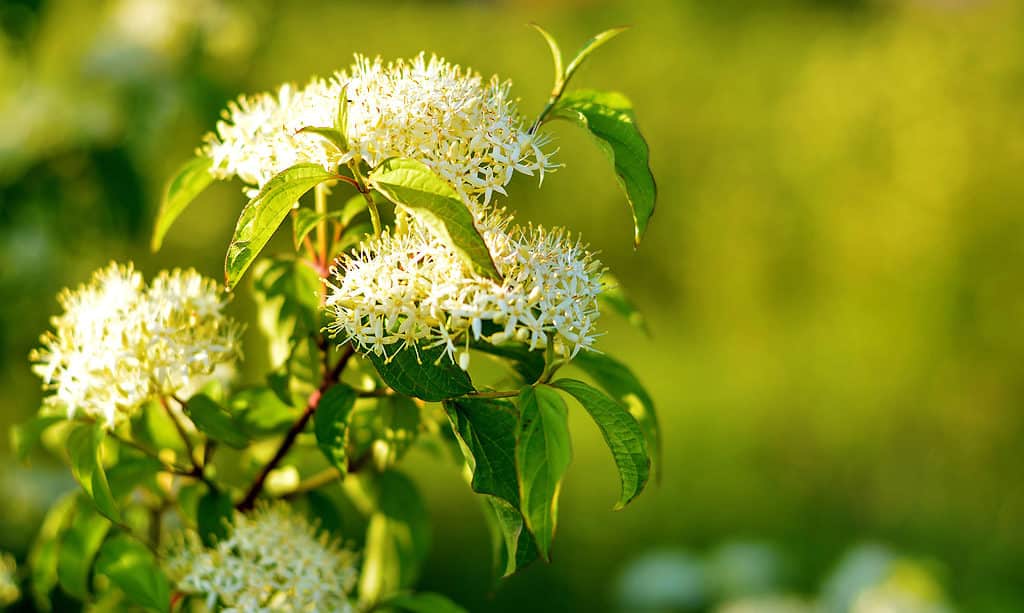
The alternate-leaved dogwood grows up to 25 feet tall and thrives in light shade.
©iStock.com/izzzy71
Pagoda dogwood (Cornus Alternifolia) is a deciduous tree with a picturesque, tiered habit. It has unique, arching branches that produce an eye-catching, pagoda-like shape. The foliage is a lovely dark green color with a bronze tinge in the fall. Its bark is dark grey and smooth. The flowers are small, creamy white clusters that are followed by attractive, bright blue fruit.
Pagoda dogwood is very cold-hardy and thrives in USDA zones 3–7. It prefers light shade but can also tolerate full sun. With very little maintenance, this tree can live up to 50 years and become a wonderful addition to any landscape.
Flowering Dogwood

The flowering dogwood tree has many common names, such as Indian arrowwood, white cornel, and false box.
©iStock.com/JillLang
Flowering dogwood (Cornus florida) is a beautiful flowering shrub native to North America. It has a broad, rounded shape, growing up to 20 feet tall with a spread of 25 feet. Its foliage is dark green and leathery, and in late spring, it produces clusters of white blooms that people sometimes mistake for petals. The blooms are followed by clusters of small, bright red fruits that persist into the fall.
Flowering dogwood is a hardy plant, able to tolerate temperatures as low as -20°F and growing in Zones 5-8. It is an excellent choice for a shady garden, as it can tolerate light shade and even full sun in cooler climates. The shrub is also drought-tolerant and resistant to disease, making it an ideal choice for the home gardener.
Kousa Dogwood

If you need a tree to grow in medium shade, consider the Kousa dogwood.
©Iryna Imago/Shutterstock.com
Kousa Dogwood (Cornus Kousa) is a beautiful tree with star-like blooms that are white in color. It has an attractive shape with its wide, spreading limbs and attractive foliage. The leaves are glossy, dark green, and oval-shaped with a pointed tip. They turn to a deep burgundy in the fall with a bright red berry. Its bark is a smooth gray with an interesting texture.
This tree requires medium to light shade and is hardy in zones 5-8. It grows up to 20 feet tall and 15 feet wide, with a rounded form and asymmetrical branching. Its blooms emerge in May-June, and then it grows bright red berries in July-August. It is an excellent choice for adding color and texture to a landscape.
American Elm

The large and stately American elm tree grows in the shade.
©iStock.com/marekuliasz
The American elm (Ulmus americana) is a beautiful, deciduous tree with a broad, rounded canopy. It can grow up to 100 feet tall and has an average spread of 50-70 feet. Its trunk is straight and slender, and its branches form a vase-like shape. The bark of an American elm is typically gray-brown in color and is deeply ridged and furrowed.
The leaves of the American elm are dark green, with a toothed margin and a pointed tip. The leaves turn a golden yellow in the fall. The tree produces small, greenish-brown flowers in the spring. Then it grows small, winged seeds after that.
American elm is a tough, hardy tree that prefers full sun but can also thrive in medium levels of shade. It is cold hardy in zones 3-9 and can tolerate a variety of soil types. It is also tolerant of air pollution.
Canadian Hemlock
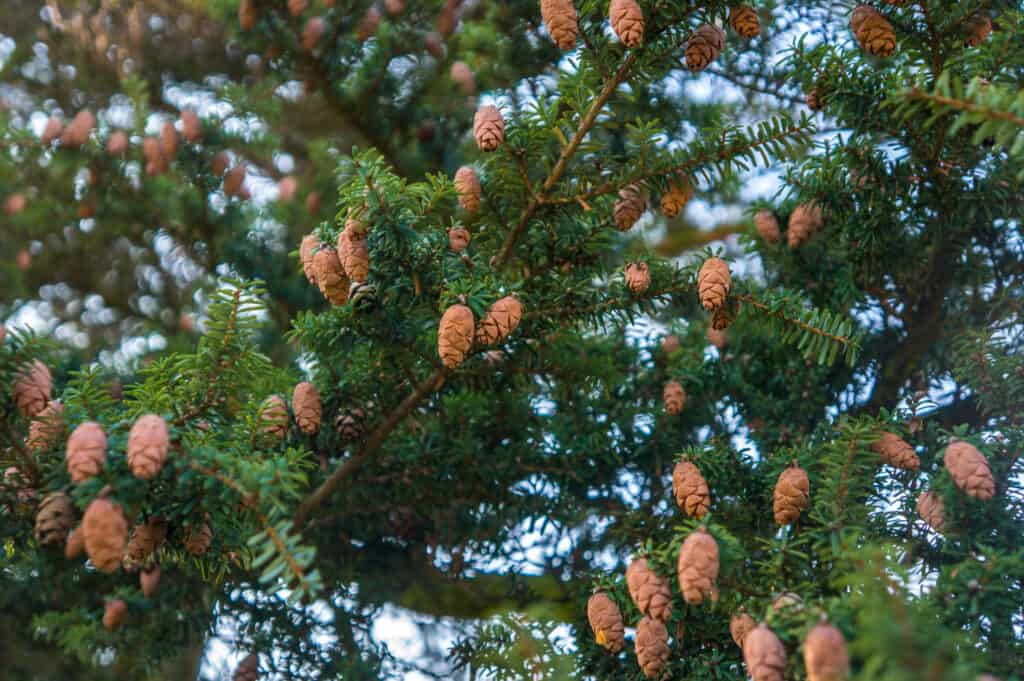
Hemlock trees can endure heavy snowfall, ice storms, and even shade.
©iStock.com/Sara Lissaker
Canadian hemlock, Tsuga canadensis, is an evergreen coniferous tree with a full, pyramidal shape. Its branches spread horizontally and hang gracefully, almost reaching the ground. The bark is thin and gray-brown, while the needles are dark green and flat, measuring 1 to 1.5 inches in length. Its cones are small, with scales that are notched at the tip.
Canadian hemlock is tolerant of medium-level shade, making it an ideal choice for yards and gardens with limited sun exposure. You can grow it in hardiness zones 3 to 7. It is very versatile in terms of soil pH and soil moisture. It is also relatively drought-tolerant once established.
Staghorn Sumac
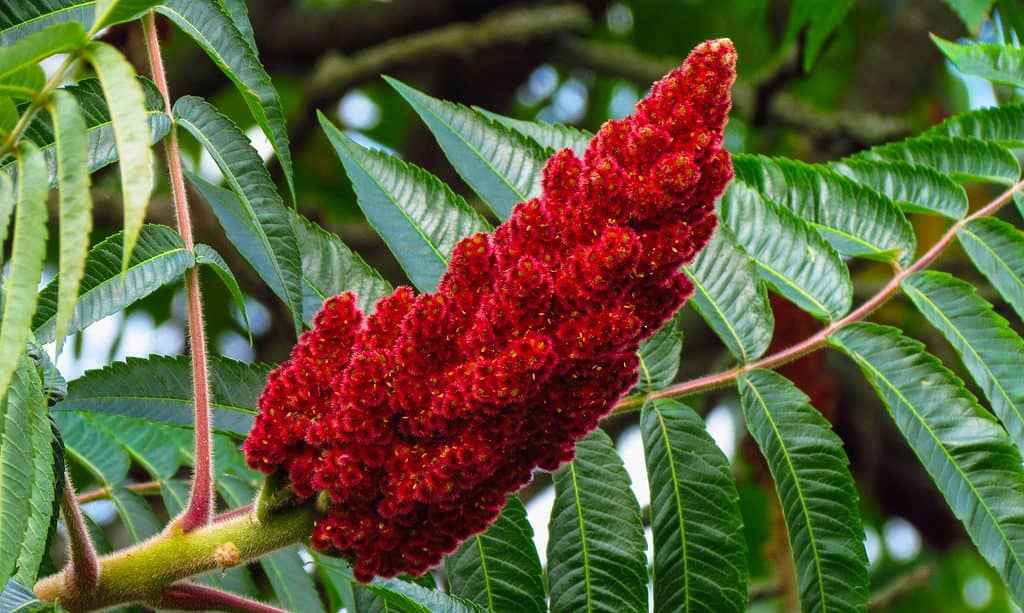
Sumac is a well-known spice found and used worldwide. It is also a tree that grows in the shade.
©shalom3/Shutterstock.com
Staghorn sumac (Rhus Typhina) is a deciduous shrub that is well-suited for landscaping. Its physical appearance is quite unique, with its stems covered in velvety, antler-like branches that grow in a fan shape. The leaves are deep green and glossy, and they turn a bright yellow hue in the fall. The flowers are fragrant and pale yellow-green, and the red fruits are edible.
This plant is quite hardy, capable of growing in zones 4-8. It is also quite adaptable, able to grow in both full sun and medium-level shade. It’s quite resilient and can withstand drought and poor soil. It can reach heights between 6 and 10 feet and can spread up to 15 feet. Staghorn sumac is an attractive addition to any garden. People use it for borders, hedges, or as an ornamental focal point.
Black Gum

The black gum tree has a light reddish-brown bark and pale yellow wood that’s very durable and tough.
©Photo by David J. Stang / CC BY-SA 4.0, via Wikimedia Commons – Original / License
Black gum, Nyssa sylvatica, is a deciduous tree with a conical shape and distinctive bark. It typically reaches heights of 30-50 feet, and its leaves are a deep green with a glossy sheen. In spring and summer, it produces small, fragrant flowers in clusters, followed by blackish-purple berries. Its bark is smooth and gray, often with a reddish hue, making it a popular choice for landscaping.
Black gum is a hardy tree, able to thrive in medium shade and climates ranging from zones 4-9. It is a popular choice for shade trees, as its leaves provide a dense canopy of cover. It also resists disease, making it a low-maintenance choice for outdoor spaces. Its deep root system also helps it to withstand drought, making it an ideal tree for drier climates.
Sweetbay Magnolia
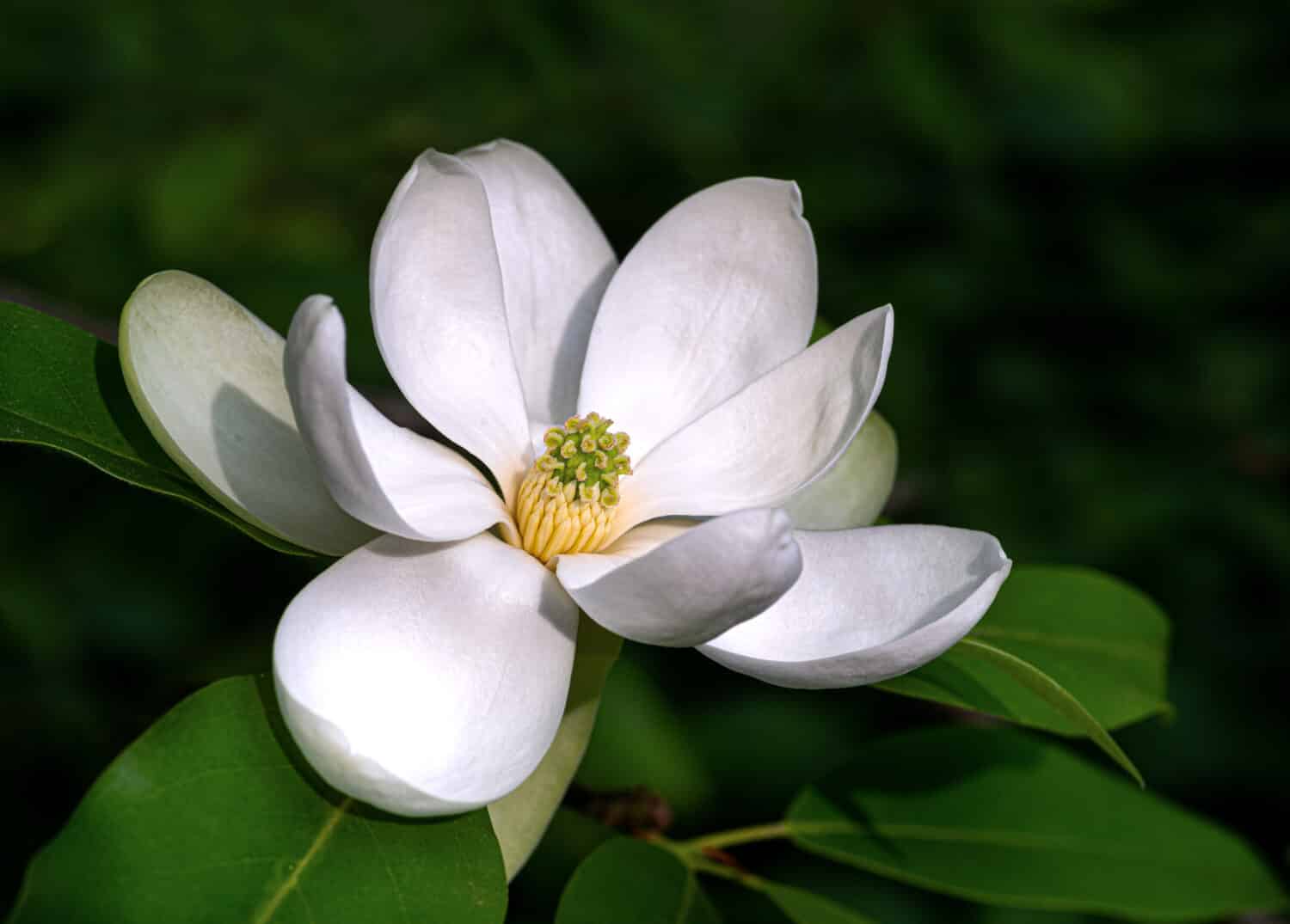
This type of magnolia tree grows well in medium-level shade.
©Gerry Bishop/Shutterstock.com
Sweetbay magnolia (Magnolia Virginiana) is a medium to large evergreen tree with an open, pyramidal-shaped crown. Its large, fragrant white flowers bloom in late spring and early summer. Its glossy, dark green leaves have a silver underside that gives the tree a shimmering effect in the wind.
This magnolia is hardy in zones 5-9 and grows well in medium-level shade. It is a popular choice for yards and gardens for this reason. The tree can reach heights of up to 35 feet, with a spread of up to 15-20 feet. It is a slow grower but can live for up to 50 years in the right conditions.
The bark of the Sweetbay magnolia is a smooth, gray-brown color. Its flowers are fragrant and typically measure up to 6 inches in diameter. The flowers are followed by red fruits that contain seeds, which attract birds to the area.
Carolina Silverbell
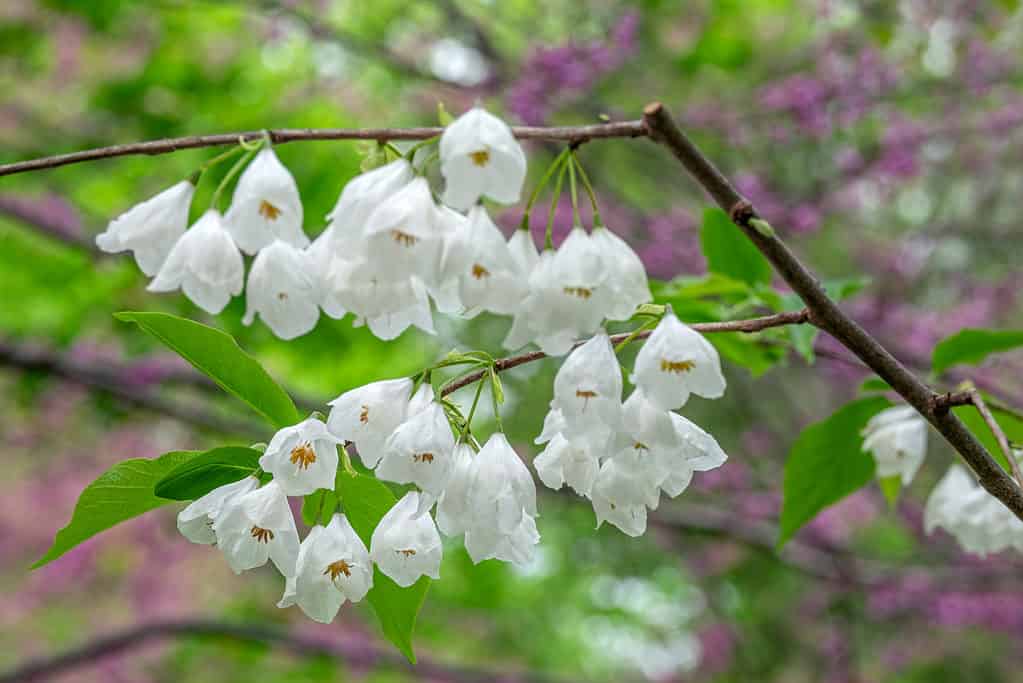
Halesia tetraptera is a gorgeous, flowering tree that grows in the shade.
©Danita Delimont/Shutterstock.com
Carolina silverbell (Halesia tetraptera) is a deciduous tree that produces beautiful white flowers in the springtime. It typically grows 30-40 feet tall and has a round or oval shape. Its bark is gray and smooth, and its leaves are oval-shaped, bright green in the summer and yellow in the fall. The most distinguishing feature is its white, bell-shaped flowers that hang down in clusters from the branches.
Carolina silverbell is a hardy tree, able to thrive in medium levels of shade and cold temperatures in zones 4-8. It is a fast-growing tree with a life expectancy of up to 30 years. This tree is an excellent choice for landscape design as it adds color and texture to any garden.
European Beech
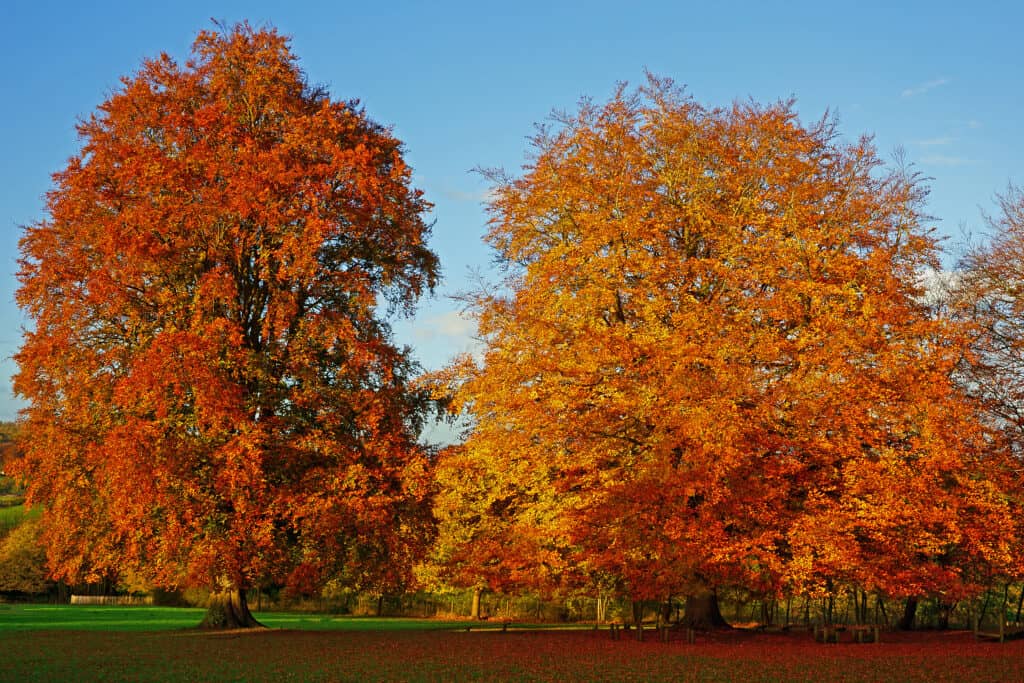
If you need a very hardy tree that adapts to the shade, choose a European Beech.
©PJ Photography/Shutterstock.com
European beech (Fagus sylvatica) is a medium to large deciduous tree, typically growing to 100-130 feet tall. It has a straight, slender trunk and a rounded, spreading crown. Its bark is smooth and grayish-silver in color, with vertical fissures and small, shallow grooves. The leaves are dark green, alternately arranged, and ovate to oblong in shape. The leaves are up to 4 inches long and 2 inches wide. The flowers are small and inconspicuous, and the fruits are small, triangular-shaped nuts.
European beech is tolerant of a range of soil conditions but prefers moist, well-drained soils and is able to thrive in medium or light levels of shade. It is hardy in zones 4-7 and is relatively resistant to pests and diseases. It is an excellent choice for windbreaks and shade trees, and people use it as an ornamental tree in parks and gardens.
4 Maple Trees That Thrive in the Shade
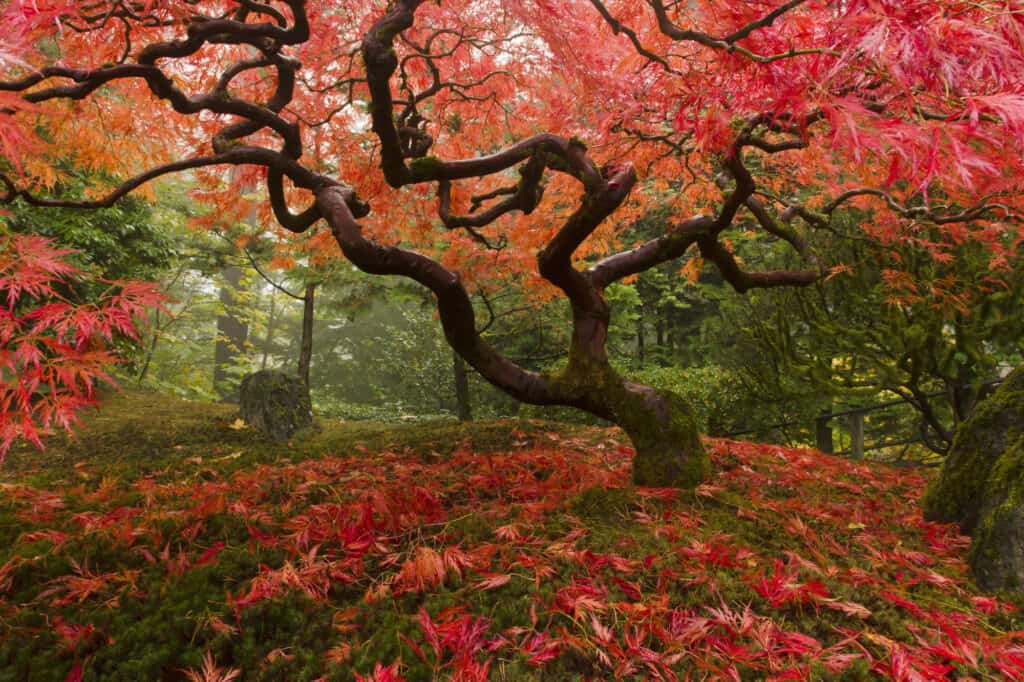
Japanese maple trees have iconic colors and grow well in the shade.
©Jason Vandehey/Shutterstock.com
There are four species of maple trees that thrive in the shade: Hedge maple (Acer campestre), Japanese maple (A. palmatum), Red maple (A. rubrum), and Sugar maple (A. saccharum).
- Hedge maple is a small, rounded tree that grows to a maximum height of 35 feet. Its leaves are small and oval-shaped with a glossy green color. This tree is hardy to zones 5-8.
- Japanese maple is a small, slow-growing tree with a spreading, rounded crown. Its leaves are deeply lobed and may be green, red, or purple in color. This tree is hardy in zones 5-8
- Red maple is a medium-sized tree with a rounded crown. It has dark green leaves that turn bright red in the autumn. This tree is hardy in zones 3-9.
- A sugar maple is a large, symmetrical tree with a rounded crown. Its leaves are five-lobed and have a deep green color in the summer. This tree is hardy in zones 4-8.
Summary of 22 Amazing Trees That Grow and Thrive in Shade
| Tree Name | Height/Spread | Hardiness Zone | |
|---|---|---|---|
| 1 | Concolor Fir | 80 ft /15-25 ft | 4-7 |
| 2 | Red Buckeye | 6-12 ft/6-10 ft | 5-9 |
| 3 | Black Alder | 40-60 ft/20-40 ft | 4-7 |
| 4 | Allegheny Serviceberry | 30-40 ft/15-20 ft | 4-8 |
| 5 | PawPaw | 25 ft/15-20 ft | 5-8 |
| 6 | American Hornbeam | 20-40 ft/20-30 ft | 3-9 |
| 7 | European Hornbeam | 30-40 ft/20-30 ft | 5-7 |
| 8 | Eastern Redbud | 20-30 ft/20-30 ft | 4-9 |
| 9 | Pagoda Dogwood | 15-25 ft/20-30 ft | 3-7 |
| 10 | Flowering Dogwood | 40 ft/15-20 ft | 5-8 |
| 11 | Kousa Dogwood | 30 ft/20-30 ft | 5-8 |
| 12 | American Elm | 100 ft/50-70 ft | 3-9 |
| 13 | Canadian Hemlock | 40-70 ft/25-35 ft | 3-7 |
| 14 | Staghorn Sumac | 15-25 ft/20-30 ft | 4-8 |
| 15 | Black Gum | 30-50 ft/20-30 ft | 4-9 |
| 16 | Sweetbay Magnolia | 35 ft/15-20 ft | 5-9 |
| 17 | Carolina Silverbell | 30-40 ft/20-35 ft | 4-8 |
| 18 | European Beech | 80-100 ft/50-70 ft | 4-7 |
| 19 | Hedge Maple | 35 ft/35 ft | 5-8 |
| 20 | Japanese Maple | 25 ft/15 ft | 5-8 |
| 21 | Red Maple | 30 ft/60 ft | 3-9 |
| 22 | Sugar Maple | 80 ft/40 ft | 4-8 |
Thank you for reading! Have some feedback for us? Contact the AZ Animals editorial team.

